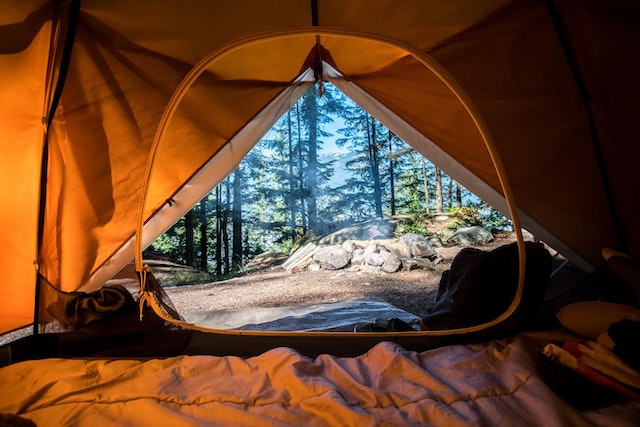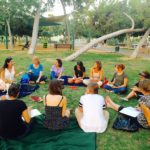Why We Chose Tiny Living and Travel

“Brick-and-mortar” structures are not things my husband and I think about these days. We haven’t for quite a while now that we are traveling full time around the U.S. indefinitely in a twenty-six-feet-long travel trailer with our six-year-old daughter. We are a long way from staying put, especially in a permanent edifice, which requires so much of us.
Tiny living and travel — slow travel at that — is not for everyone. It requires a lot from folks, too, mostly a shedding of certain comforts, particularly material possessions that make up house and home, and a willingness to go with the flow. Although going simple was not easy, for me and my family, downsizing to and traveling in a tiny house on wheels was one of the most natural paths we’ve ever taken. Ridding ourselves of weighty things stuck inside of four stationary walls opened us up entirely to a world of freedom. Our story goes like this.
Ridding ourselves of weighty things stuck inside of four stationary walls opened us up entirely to a world of freedom.
Unbeknownst to us at the time, the journey we are now on began the moment we decided to declare bankruptcy, which happened officially in May of 2010. My husband, a web developer, sold raw land online with his business partner at the time. Things had been going well financially for all of us, and we all had fun with our small fortune, including buying stuff for homes, a cabin and an office building in Arizona, where we lived. But then, as the housing market began to go kaput, so did the abilities of those who had been buying up real estate all over the country through my husband’s business. No loans, no credit, no credit cards. As financial resources were drying up for everyone else, so was our cash cow.
Aware that the eternal fountain of financial good fortune via real estate might not last forever, my husband and his business partner were creating other businesses to continue recurring revenue streams. One of these businesses seemed a good fit for the changing economy, but it wasn’t the best fit for them as it was becoming a far-reaching endeavor with little profit. As it turned out, nothing was quite as lucrative as selling land, so they refocused.
But it was not meant to be. The recession was headed into full swing, and the financial domino effect found its way to us as well. With few financial resources available to investors, people stopped buying land, and so went the real estate business, almost overnight. An all-in ante on the new business, plus a personal guarantee signed on their building sealed our fate. Our trajectory was set. Purging and planning began.
Why We Chose Tiny Living and Travel.
Fast-forward a couple of years later. With a new baby in tow, the illnesses and passing of a few close family members and our general dissatisfaction with living any longer in the desert, we moved back to the Midwest to start anew. We had lived off of things that we could sell — the prizes, so to speak, of our financial gains — and we forfeited the rest. Even after the purging and selling of the contents of our house, the cabin and the office building, we still moved cross-country with an overstuffed twenty-six-feet-long (coincidentally) rented truck and six-by-twelve pull-behind trailer that we hauled with our remaining vehicle. How could it be possible that we had so much stuff still? It was mind-boggling and a bit embarrassing, and it was just the beginning.
There was more in the Midwest. We shared the home that belonged to my mother. My stepfather had passed, and she was alone in an enormous house. She had lots of stuff, too. My grandmother, a recent widow herself who lived just down the street from my mother, was succumbing to dementia. The sale of her house and most of its contents landed in our laps also. We already had off-loaded what we could of three structures in Arizona, and now we essentially had inherited the contents of a few more. How had it come to this? So much stuff. Houses full of stuff. Generations of stuff. Lifetimes of stuff. We weren’t rare. It is part of the American Dream, the having of home and the accumulation of stuff. We simply had been doing our part.
The having of stuff takes so much time and energy. It needs to be rearranged, it needs to be dusted. It needs space and shelves. It needs order. The more we had, the more mental energy went into dealing with it. It was exhausting, and it seemed to have gone on forever; it had only been a couple of years. My husband and I had become pretty good at the emotional detachment of material possessions. Now, we were full-on pros. It had permanently changed our thinking.
We weren’t rare. It is part of the American Dream, the having of home and the accumulation of stuff. We simply had been doing our part.
It was at this point that we were realizing our trajectory and holding on tightly. Lots of things need lots of space in which to put them. We no longer wanted either of those aspects to play a role in our lives, and it was actively part of our discussions. With little in our possession, we could live smaller. A lighter load meant more experiences and fewer obligations. So we kept purging and talking and dreaming.
While this was happening, my husband had started a new business in web development. We also had become practitioners of attachment parenting and we were bonding as a family. We co-slept. We spent most of our time together. We were united. My husband, who worked from home or close to it, was around often. As our daughter was growing, I couldn’t imagine her away from us regularly for someone else to “raise,” and so we began to question conventional schooling.
All of a sudden, things began to crystallize. We no longer wanted or needed lots of things, nor a large place in which to house them, and we were freeing ourselves from the rest of the typical community ties that bind: If my husband could work from anywhere and our daughter could be “schooled” anywhere, then we could be or go anywhere.
And so a spreadsheet began, a spreadsheet about home. A list of the what, where, when, why and how of our future. What did we want to do? Where did we want to go, and when? Why do we want to go there? How can we do it? It screamed possibilities. It unveiled dreams. It spoke of pure creativity. It echoed freedom. Joy began rising. Could this really be happening? Could it really be possible that we might do … anything and everything? The truth of the matter was beginning to unfold.
We continued to make lists. What became apparent was that living somewhere specifically meant another all-in commitment of sorts — rent for a year, a down payment for something purchased, the costs of moving. What little cash we had saved post-bankruptcy would disappear with the writing of a check or the swipe of a debit card, and for what? To stay or live in San Diego or Grand Rapids or Austin while we kept saving and waiting and watching the world go by us? No thanks. It was clear. We wanted to see everything and go everywhere and not be confined to one place and time and space. We wanted to do it all.
Why We Chose Tiny Living and Travel.
And then, it happened. The moment of clarity struck in the form of a camper.
Needing time away from our regular routine, we began to look at camping in a travel trailer. We had visited this option previously, but the timing was not right for us to go. But during one week one late summer ago, we did go. Searching the Internet for possible camping options, we stumbled upon a campground that offered stationary travel trailers for rent. The tagline read, “Maybe you want to give this whole camping thing a try … maybe you’re just tired of tenting. Whatever your reason, let our rental campers be the solution.” We were hooked.
From the moment we stepped into the thirty-two-foot camper, we knew that this was it. Our daughter felt as though she had entered an immense play house. My husband just smiled for a long time. I liked the sense of small, of intimate, of low-key. For seven days, we hiked and swam and talked around campfires. We gazed at the stars. We visited local places. We made food, and we made plans.
Eight months later, we acquired our own tiny house on wheels — all two hundred square feet of it — our version of mobile apartment living. Shortly after that, we began traveling part time as we wrapped up things in our brick-and-mortar structure and gifted them, donated them or sold them. We kept only what was deemed important — memorabilia, a few kitchen items, art — and stashed it in a five-by-seven-by-seven crate, which resides on the third level of a warehouse in the Midwest. Attached to it is a personal note from our past selves to our future selves with questions about whether we kept too much or too little, how we feel about our endeavor and what we know. And then, we departed for full time travel.
We are working, writing and playing nomads, traveling slowly in a tiny house on wheels, carrying just what we need along the way.
Initially, our plans were to travel for a year-and-a-half around the U.S., and then it would be off to Europe or Alaska. Now, after only traveling for four months, we know that there is no end in sight, that there is so much to see and we want to see it all. We are working, writing and playing nomads, traveling slowly in a tiny house on wheels, carrying just what we need along the way.
Once upon a time, we had money and things. Inevitably, both became a burden. It took time for renewal. However, we are grateful: The lessons learned and wisdom gained are gifts to us, and continue to be. Now, we have little money and few things, but we are truly free. We are seeing the world on our own terms on our own time with just experiences and people and cultures awaiting us. I can’t imagine doing anything else right now. Tiny living and travel is how we call home. It’s the place to be.









Great article written by a brave, wise, and adventuresome woman. I’m looking forward to her next submission!